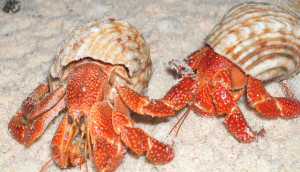When I chose hermit crabs as my topic for this month, I wasn’t exactly sure what I would find. It turns out that hermit populations are generally in good shape at this moment [although the popularity of hermit crabs in the aquarium industry does warrant a little concern- because of the effort and expense needed to provide hermit crabs with a supply of suitable shells, farmed crabs would be expensive, so the crabs continue to be collected from the wild (Calado et al. 2003)]. And some of our marine activities appear to benefit these scavengers- hermit crab biomass increased in response to fishing and trawling activities off the coast of the UK (Kaiser et al. 2000) and hermits not only ate the discards of fisheries in the Irish Sea, but also ate more in general in areas disturbed by fishing (Ramsay et al. 1997).
But while now seems okay, the future is less certain. Hermit crabs are limited on several levels by the availability of suitable snail shells (Mesce 1982)- crabs are more abundant, more reproductive, and grow faster when more good shells are available, and they will fight each other to get to better shells (Vance 1972). Once they have access to a suitable shell for their size and habitat, they tend to have a limited amount of time before the shell becomes too damaged or degraded for use. Kuris et al. (1979) found that shells demonstrated wear within 3 months of being inhabited by a hermit crab and were too damaged for use by the end of 9 months- at that rate, a constant sourse of good shells is imperative for any hermit crab population. Hermit crabs use chemoreceptors in their antennules to detect snail predation events (because dead snails mean new real estate may have come on the market) and to assess the quality of shells they encounter (Wilber and Herrnkind 1982).
Why is the future hermit crab housing market less than rosy? Ocean acidification. As atmospheric carbon dioxide levels have risen, levels of carbon dioxide dissolved in ocean water have also increased. This causes the water to become more acidic (with a lower pH), and we’ve already seen a 0.1 pH drop in ocean surface water in the past 100 years (Caldeira and Wickett 2003; Solomon et al. 2007). This trend is expected to continue and accelerate in the future. Why are acidic oceans bad for snail shells? Aquatic habitats with lower pH have less calcium carbonate available for those animals that use it to build shells and parts of their skeleton. When Hale et al. (2011) studied how increases in ocean acidification would affect marine invertebrates, molluscs (including snails) and echinoderms (like sea urchins) almost completely disappeared from the areas with a pH of 7.3 or lower. No snails means no snail shells for hermit crabs.
I had expected that a drop in ocean pH and the associated loss of access to calcium carbonate would cause problems for snails and, by extension, hermit crabs, but I hadn’t expected the results of de la Haye et al. (2011) when they looked at hermit crab behavior in lower pH water. Pagurus bernhardus crabs exposed to higher acid levels were less likely to change from an inadequate shell when presented with a better one, and took significantly longer to make the move if they did change shells. More time spent making the move means more time exposed to predators, which could be a problem. In addition, crabs in the more acidic environments moved more slowly and spent less time assessing the environment with their antennules. If lowered pH makes crabs slower and less aware of their environments, it could really change the way that they interact with other species and the roles that they play in ecosystems.
So, although I couldn’t find much in the way of immediate threats to hermit crabs, it seems like they are predicted to have a bumpy ride as climate change effects continue to develop. In my next post, I’ll try to get a handle on the nuances of those effects and ways that we might be able to counter them.
Works cited:
Caldeira, K and M Wickett. 2003. Anthropogenic carbon and ocean pH. Nature 425: 365.
Calado, R, Lin, J, Rhyne, AL, Araujo, R, and L Narciso. 2003. Marine ornamental decapods: popular, pricey, and poorly studied. Journal of Crustacean Biology 23: 963-973.
De la Haye, KL, Spicer, JI, Widdicombe, S, and M Briffa. Reduced sea water pH disrupts resource assessment and decision making in the hermit crab Pagurus bernhardus. Animal Behaviour 82: 495-501.
Hale, R, Calosi, P, McNeill, L, Mieszkowska, N, and S Widdicombe. 2011. Predicted levels of future ocean acidification and temperature rise could alter community structure and biodiversity in marine benthic communities. Oikos 120: 661-674.
Kaiser, MJ, Spence, FE, and PJB Hart. 2000. Fishing-gear restrictions and conservation of benthic habitat complexity. Conservation Biology 14: 1512-1525.
Kuris, A, Brody, M and J Carlton. 1979. Experimental field study of hermit crab resource utilization: snail shell wear and movement. Bulletin of the Ecological Society of America 60: 118.
Mesce, KA. 1982. Calcium-bearing objects elicit shell selection behavior in a hermit crab. Science 215: 993-995.
Ramsay, K, Kaiser, MJ, Moore, PG, and RN Hughes. 1997. Consumption of fisheries discards by benthic scavengers: utilization of energy subsidies in different marine habitats. Journal of Animal Ecology 66: 884-896.
Solomon, S et al. 2007. Technical summary. In: Solomon, S et al. (eds.), Climate Change 2007: the physical science basis. Contrib. Working Grp 1 to the 4th Assess. Rep. Intergovernmental Panel on Climate Change. Cambridge University Press.
Vance, RR. 1972. The role of shell adequacy in behavioral interactions involving hermit crabs. Ecology 53: 1075-1083.
Wilber, Jr., TP and W Herrnkind. 1982. Rate of new shell acquisition by hermit crabs in a salt marsh habitat. Journal of Crustacean Biology 2: 588-592.

